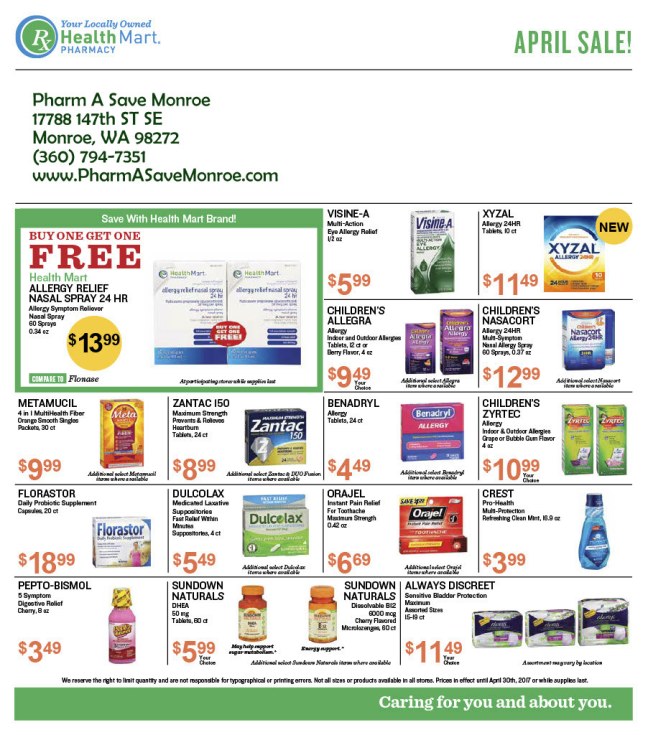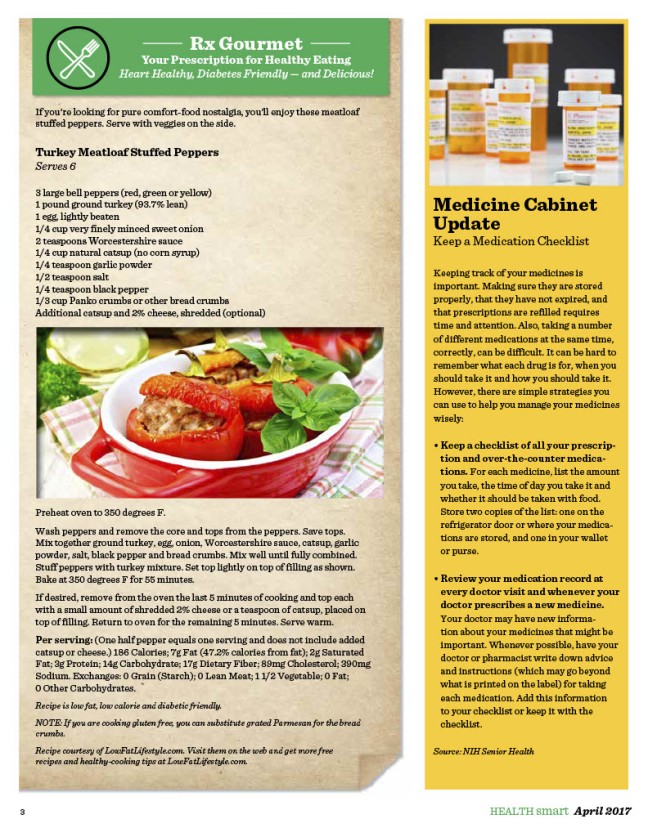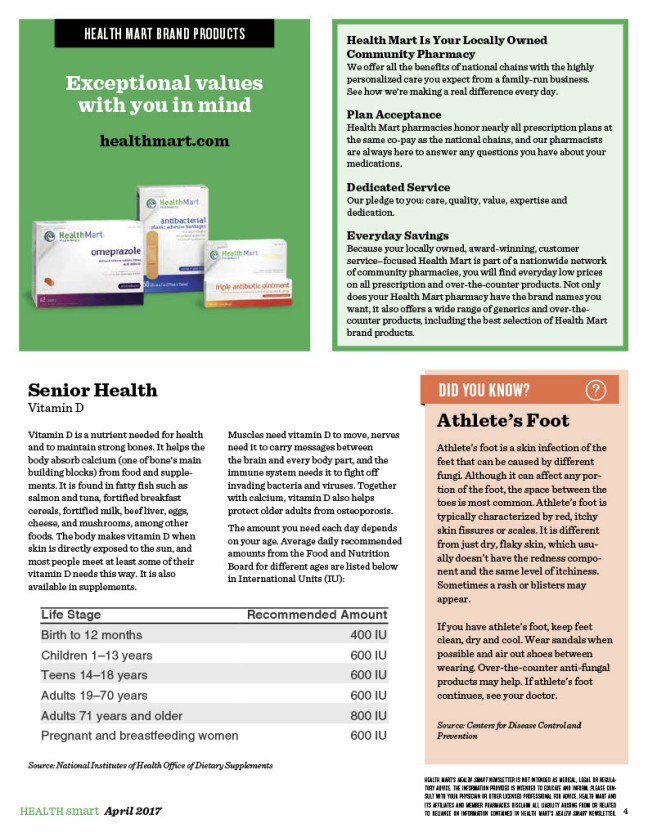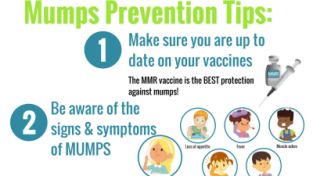

April 2017 Health Mart Circular










Mumps is a  contagious disease caused by a virus. It spreads through saliva or mucus from the mouth, nose, or throat. An infected person can spread the virus by
contagious disease caused by a virus. It spreads through saliva or mucus from the mouth, nose, or throat. An infected person can spread the virus by
Mumps likely spreads before the salivary glands begin to swell and up to five days after the swelling begins.
Mumps is best known for the puffy cheeks and swollen jaw that it causes. This is a result of swollen salivary glands.
The most common symptoms include:
Symptoms typically appear 16-18 days after infection, but this period can range from 12-25 days after infection.
Some people who get mumps have very mild or no symptoms, and often they do not know they have the disease.
Most people with mumps recover completely in a few weeks.
In some years, there are more cases of mumps than usual because of outbreaks. Mumps outbreaks can occur any time of year. A major factor contributing to outbreaks is being in a crowded environment, such as attending the same class, playing on the same sports team, or living in a dormitory with a person who has mumps. Also, certain behaviors that result in exchanging saliva, such as kissing or sharing utensils, cups, lipstick or cigarettes, might increase spread of the virus.
MMR vaccine prevents most, but not all, cases of mumps and complications caused by the disease. Two doses of the vaccine are 88% (range: 66 to 95%) effective at protecting against mumps; one dose is 78% (range: 49% to 92%) effective. The MMR vaccine protects against currently circulating mumps strains. Outbreaks can still occur in highly vaccinated U.S. communities, particularly in close-contact settings. In recent years, outbreaks have occurred in schools, colleges, and camps. However, high vaccination coverage helps limit the size, duration, and spread of mumps outbreaks.
Although it is not mandatory to report mumps outbreaks to CDC, many health departments will contact CDC when they experience an unusually high number of cases. In 2015 and 2016, a number of cases and outbreaks have been reported to CDC, primarily associated with college settings. These outbreaks have ranged in size from a few to several hundred cases, have mostly affected young adults, and are likely due to a combination of factors. These factors include the known effectiveness of the vaccine, lack of previous exposure to wild-type virus, and the intensity of the exposure setting (such as a college campus) coupled with behaviors that increase the risk of transmission.
Resources: https://www.cdc.gov/mumps/outbreaks.html
Signs & Symptoms: https://www.cdc.gov/mumps/about/signs-symptoms.html
For information about how to prevent mumps from spreading, see Outbreak-Related Questions and Answers for Patients.
Vaccine Schedule for Children & Adults

We are all looking forward to better weather , and some of you have been lucky enough to have a vacation planned for some warmer weather! Don’t forget about your feet!
Don’t wear those flat $ 1.00 flip flops. If you haven’t figured it out yet, those puppies may be such a great price, you can afford them in several colors and styles. But, at what expense? Plantar Fasciitis?
Or, maybe you do not get the opportunity to wear those cute flip flops, because your knees, back and feet say “No Way!”. What if I told you that Pharm A Save Monroe has a solution?
Vionic shoes – Reclaim your footprint. www.vionicshoes.com
Feet were designed to walk on soft, natural elements like soil and sand, not the hard, flan man-made surfaces that make up so much of our modern world. With Vionic’s innovative biomechanical technology, Vionic shoe and sandals hug your arches like a matural footprint, giving you all-day support.
With all that, to the point ALL VIONIC SANDALS, SHOES AND SLIPPERS are on sale now thru April 31st, 2017! How about this — 40% off. (In Stock Items Only!)
Make your feet happy – Walk.Move.Live.


“Why can’t I lose weight?” is a question that many of us have asked ourselves. However, effective weight loss means dealing with several variables.
What ANY animal is designed to eat for a healthy life is known as its diet. A weight loss plan is not a diet, but a special program designed to encourage consumption of calories that are being stored in the body as fat. A weight management diet is used to retrain and recondition the body so that weight does not return. Popular weight management diets are the Mediterranean Diet, the Elimination Diet, the Gluten Free Diet and the Paleolithic Diet. Generally, a weight loss plan is used for 30 days and then followed by 30 days of a weight management diet, with the sequence repeated until the desired weight is lost. For successful weight loss, an individual cannot return to the diet that created the weight gain to begin with.
Written by: Wellness Works – Monthly Nutritional Practice www.wellnessworks.com
Pharm A Save is an authorized retailer of Wellness Works Nutritional Products. Pharmacist Recommended !

As soon as the weather changes, as soon as we get to at least 50 degrees, I am opening the doors in my house, opening the windows and letting all of the fresh air in. My mind goes into overdrive and I am wanting to get outside and work in the dirt that I call MY garden. If anyone else looked at the mess, they would wonder why I waste my time with that mess. It is MY rewarding mess.
As soon as the days get longer, we feel the need to clean out and purge. That’s a good thing. Get rid of all of the stuff that has been building up with no use or no where to put it. This happens also when families are trying to find useful places for old medical equipment that is no longer needed.
If you have a wheelchair, a walker, used hospital bed, you can donate it to Good Will or maybe post it on a board at your local senior center. Once the word gets out that these type of items are available, they will go quickly. Remember to clean them up so they are clean and ready for the next user. A little Pine Sol or Clorox mixture go along way.
Then there are the “soft goods” like packages of diapers, pads and washable pads. As long as they have not been used, the nursing homes, adult family homes and senior centers are always appreciative with that type of donation.
So , when the sun starts to shine, the days get longer and the breeze starts to clean the air, remember that all of “the stuff” can be paid forward to be part of someone else’s stuff.
Let’s talk again,
** Remember, when you wake in the morning, Give thanks!
Sue Graafstra
Pharm A Save Medical Equipment and Supply
360-794-4641 ext 200

Eight out of 10 people living with vision loss worldwide could have saved their sight through prevention or treatment.1 Pretty amazing, isn’t it? Of course, seeing your doctor for eye exams and treatment is key.
Here are a few other things you can do help ensure your eyes have a bright future:
The researchers found that fiber, beta-carotene, and vitamins C and E seemed to be most protective. (Surprisingly, people who consumed more caffeine also had less AMD.)3
Other research has also shown that zinc, lutein, xeaxanthin, and omega-3 fatty acids may protect not only from AMD, but also cataracts and dry eye. You can find these nutrients in citrus fruits, vegetables oils, nuts, whole grains, dark green leafy vegetables, and cold-water fish like salmon.4 Some people should not take large doses of antioxidants for medical reasons. So be sure to talk your doctor or me if you have any questions about this.
If you are at risk for diabetes or AMD, you may also benefit from a low-glycemic index diet. What is this? Avoid foods that quickly raise your blood sugar, such as sweets and white bread.4
Nothing herein constitutes medical advice, diagnosis or treatment, or is a substitute for professional advice. You should always seek the advice of your physician or other medical professional if you have questions or concerns about a medical condition.
Sources: